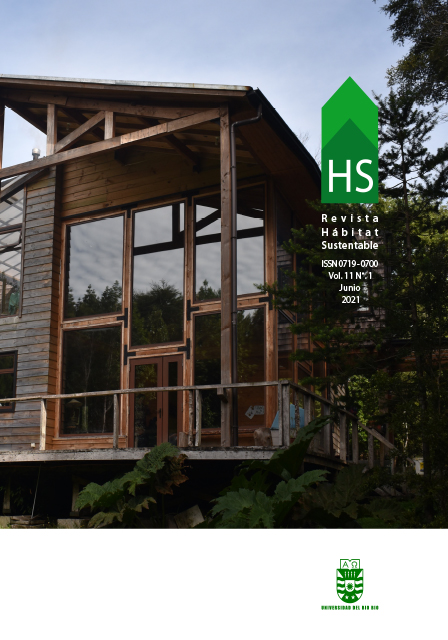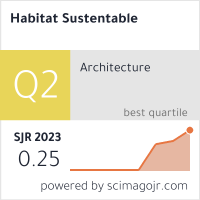Mejoras de eficiencia energética en calefacción. Potencial de intervención en edificio escolar existente del área Metropolitana de San Juan, Argentina
DOI:
https://doi.org/10.22320/07190700.2021.11.01.02Palabras clave:
escuelas, rehabilitación energética, eficiencia energía, simulaciónResumen
El cambio climático, el constante crecimiento del consumo energético y los altos niveles de emisiones que registra el sector energético, requieren de la implementación de soluciones concretas. La rehabilitación de edificios ofrece una oportunidad significativa para contribuir en este aspecto. El objetivo del presente trabajo es analizar el potencial de intervención en un edificio escolar perteneciente al Programa Nacional 700 Escuelas. Las mejoras en eficiencia energética se evalúan a través de simulación dinámica y se calculan indicadores respecto al consumo anual de energía para calefacción. Los valores para el edificio de referencia son de 74,5 kWh/m2 año y de 158 kWh/alumno. Con las propuestas de rehabilitación se podrían alcanzar ahorros energéticos de entre 39,7% y 60%. La alternativa R-Media se presenta como la más conveniente al lograr beneficios energéticos del 47%, con menores costos de inversión. Los indicadores de eficiencia energética para dicho conjunto de mejoras son de 39,2 kWh/m2 año y de 83,1 kWh/alumno. Los resultados alcanzados pueden servir de referencia para la rehabilitación de 71 edificios escolares erigidos en la provincia de San Juan entre los años 2004 y 2015, los cuales responden a una tipología constructiva con similitudes de materialización de la envolvente y configuración funcional.
Descargas
Citas
ANDERSEN, M., DISCOLI, C.A., VIEGAS, G.M. Y MARTINI, I. (2017). Monitoreo energético y estrategias de retrofit para viviendas sociales en clima frío. Hábitat Sustentable, 7(2), 50-63. DOI: https://doi.org/10.22320/07190700.2017.07.02.05
ANSI/ASHRAE (2019). Standard 62.1-2019. Ventilation for Acceptable Indoor Air Quality. ASHRAE and the American National Standards Institute.
ASHRAE (2020). Reopening of schools and universities. Recuperado de https://www.ashrae.org/technical-resources/reopening-of-schools-and-universities
ATTIA, S., SHADMANFAR N. Y RICCI, F. (2020). Developing two benchmark models for nearly zero energy schools. Applied Energy 263, art. 114614. DOI: 10.1016/j.apenergy.2020.114614
AUTODESK (2011). Ecotect Analysis. Sustainable Building Design Software. Recuperado de www.autodesk.com/ecotect-analysis.
BARBOSA, F.C., DE FREITAS, V.P. Y ALMEIDA, M. (2020). School building experimental characterization in Mediterranean climate regarding comfort, indoor air quality and energy consumption. Energy & Buildings, 212. DOI: 10.1016/j.enbuild.2020.109782
BOUTET, M.L., HERNÁNDEZ, A. Y JACOBO, G. (2020). Methodology of quantitative analysis and diagnosis of higro-thermal and lighting monitoring for school buildings in a hot-humid mid-latitude climate. Renewable Energy, 145, 2463-2476. DOI: 10.1016/j.renene.2019.08.009
CAPOREALE P.E, MERCADER MOYANO, M. P. Y CZAJKOWSKI, J. D. (2017). Multi-objective optimisation model: A housing block retrofit in Seville. Energy & Buildings, 153, 476–484. 10.1016/j.enbuild.2017.08.023
ENRE (2020). Ente Nacional Regulador de la Electricidad. Ministerio de Desarrollo Productivo. Recuperado de https://www.argentina.gob.ar/enre/uso-eficiente-y-seguro/consumo-basico-electrodomesticos.
ESTEVES, A. (2017). Arquitectura bioclimática y sustentable: Teoría y práctica de la conservación de la energía. Sistemas solares pasivos y enfriamiento natural de edificios. Mendoza: FAUD, UM; INHAE, CCT-CONICET.
ESTEVES, A., ESTEVES, M.J., MERCADO, M.V., BAREA, G. Y GELARDI, G. (2018). Building Shape that Promotes Sustainable Architecture. Evaluation of the Indicative Factors and Its Relation with the Construction Costs. Architecture Research, 8(4), 111-122. DOI:10.5923/j.arch.20180804.01
GERALDI, M. S. Y GHISI, E. (2020). Mapping the energy usage in Brazilian public schools. Energy & Buildings, 224, 1-17. DOI=10.1016/J.ENBUILD.2020.110209
GODOY-MUÑOZ, A. (2015). Validación y calibración de la simulación energética de edificios La importancia del análisis de sensibilidad e incertidumbre. Tesis de Doctorado en Sostenibilidad, Universidad Politécnica de Catalunya.
HARISH, V. S. K. V. Y KUMAR, A. (2016). A Review on Modeling and Simulation of Building Energy Systems. Renewable and Sustainable Energy Reviews, 56, 1272–1292. DOI: 10.1016/j.rser.2015.12.040
IEA (2018). Informe Global. Hacia un sector de edificios y de la construcción eficiente, resiliente y con cero emisiones. Global Alliance for Buildings and Construction (GlobalABC). Coordinado por el Programa del Medio Ambiente de las Naciones Unidas. Recuperado de www.iea.org.
IRAM (2002). 11605. Acondicionamiento térmico de edificios. Condiciones de habitabilidad en Edificios. Revisión 2002. Instituto Argentino de Normalización.
IRAM (2002). 11601. Aislamiento térmico de edificios. Métodos de cálculo. Instituto Argentino de Normalización.
IRAM (2012). 11603. Acondicionamiento térmico de edificios. Clasificación bioambiental de la República Argentina. Instituto Argentino de Normalización.
IRAM (2017). 11900. Prestaciones energéticas en viviendas. Método de cálculo. 2° Edición. Instituto Argentino de Normalización.
KHAN, H.S., ASIF, M. Y MOHAMMED, M.A. (2017). Case Study of a Nearly Zero Energy Building in Italian Climatic Conditions. Infrastructures, 2(4), 19. DOI: 10.3390/infrastructures2040019
KUCHEN, E. Y KOZAK, D. (2020) Transición energética argentina. El nuevo estándar de eficiencia energética en la evaluación de la vivienda social. Caso de estudio: Vivienda de Barrio Papa Francisco. Hábitat Sustentable, 10(1), 44 -55. DOI: https://doi.org/10.22320/07190700.2020.10.01.04 HS
MINISTERIO DE EDUCACIÓN (1998). Criterios y Normativa Básica de Arquitectura Escolar. Dirección de Infraestructura. Gobierno de la Nación. Argentina.
PONTORIERO, D. (2017). Banco de datos meteorológicos, 2006 a 2015. Instituto de Energía Eléctrica, Facultad de Ingeniería, Universidad Nacional de San Juan.
RÉ, M.G. (2017). Arquitectura escolar. Análisis del Programa Nacional 700 Escuelas en la Provincia de San Juan. Actas del XXI Congreso ARQUISUR. Eje 1. Trabajo Nº30. En: https://www.researchgate.net/publication/320300087_ARQUITECTURA_ESCOLAR_ANALISIS_DEL_PROGRAMA_NACIONAL_700_ESCUELAS_EN_LA_PROVINCIA_DE_SAN_JUAN
RÉ, M.G., BLASCO LUCAS, I. Y FILIPPÍN, C. (2016). Evaluación higrotérmica y energética de un edificio escolar perteneciente al Programa Nacional 700 Escuelas, en el Área Metropolitana de San Juan, Argentina. Hábitat Sustentable, 6(2), 40-51.
ROCKY MOUNTAIN INSTITUTE [RMI] (2020). Recuperado de https://rmi.org/
SAN JUAN, G. (2014). Aprendizaje en las escuelas del siglo XXI. Nota 5. Auditoría ambiental y condiciones de confort en establecimientos escolares. Banco Interamericano de Desarrollo.
SEKKI, T., ANDELIN, M., AIRAKSINEN, M. Y SAARI, A. (2016). Consideration of energy consumption, energy costs, and space occupancy in Finnish daycare centres and school buildings. Energy & Buildings 129, 199–206. DOI: 10.1016/j.enbuild.2016.08.015
SELECTRA (2020). Factor de conversión del gas natural, de m3 a kWh. Recuperado de https://preciogas.com/faq/factor-conversion-gas-natural-kwh.
TRISNAWAN, D. (2018). Ecotect design simulation on existing building to enhance its energy efficiency. IOP Conference Series: Earth and Environmental Science, 105. DOI:10.1088/1755-1315/105/1/012117
VELOSO, A.C.O. Y SOUZA, R.V.G. (2019). Peso do sistema de arcondicionado no consumo de energía eléctrica em edificacao de escritorios: estudo de caso em Belo Horizonte – Brasil. International Building Performance Simulation Association. IBPSA.
WANG, S., YAN, C. Y XIAO, F. (2012). Quantitative energy performance assessment methods for existing buildings. Energy & Buildings, 55, 873–888.
WIKIPEDIA (2020). Mapa de Argentina con localización de la provincia de San Juan. Recuperado de https://es.wikipedia.org/wiki/Provincia_de_San_Juan_(Argentina).
Descargas
Publicado
Cómo citar
Número
Sección
Licencia
Derechos de autor 2021 María Guillermina Ré, María Pía Mazzocco, Celina Filippín

Esta obra está bajo una licencia internacional Creative Commons Atribución-CompartirIgual 4.0.
El contenido de los artículos que se publican en cada número de Hábitat Sustentable, es responsabilidad exclusiva de los autores y no representan necesariamente el pensamiento ni comprometen la opinión de la Universidad del Bío-Bío.
Los autores/as conservarán sus derechos de autor y garantizarán a la revista el derecho de primera publicación de su obra, el cuál estará simultáneamente sujeto a la Licencia de Reconocimiento de Creative Commons CC BY-SA que permite a otros compartir-copiar, transformar o crear nuevo material a partir de esta obra con fines no comerciales, siempre y cuando se reconozcan la autoría y la primera publicación en esta revista, y sus nuevas creaciones estén bajo una licencia con los mismos términos.











 Programa de Información Científica/Concurso Fondos de Publicación de Revistas Científicas 2018/ Proyecto Mejoramiento de Visibilidad de Revistas UBB (Código:FP180007)
Programa de Información Científica/Concurso Fondos de Publicación de Revistas Científicas 2018/ Proyecto Mejoramiento de Visibilidad de Revistas UBB (Código:FP180007) 





